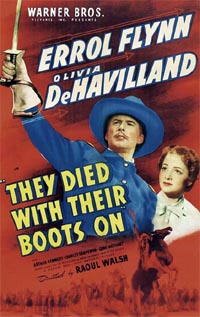- They Died with Their Boots On
Infobox Film
name = They Died with Their Boots On
imdb_id = 0034277

producer =Hal B. Wallis Robert Fellows
director =Raoul Walsh
writer =Wally Kline andÆneas MacKenzie (screenplay)
starring =Errol Flynn Olivia de Havilland
music =Max Steiner
cinematography =Bert Glennon
editing =William Holmes |
distributor =Warner Bros.
released =November 21 ,1941
runtime = 140 min.
language = English"They Died with Their Boots On" is a 1941 western film directed by
Raoul Walsh and starringErrol Flynn andOlivia de Havilland . Despite being rife with historical inaccuracies, the film was one of the top-grossing films of the year, being the last of eight Flynn-de Havilland collaborations.Plot
The film follows the life of
George Armstrong Custer (Errol Flynn ) from attending West Point, wooing of Elizabeth Bacon (Olivia de Havilland ) who becomes his loving wife, theAmerican Civil War , and theBattle of Little Big Horn . In the film, the battle is blamed on unscrupulous corporations and politicians craving the land ofCrazy Horse (Anthony Quinn ) and his people.Custer is portrayed as a fun-loving but almost saintly figure who tirelessly works for Indians and sacrifices himself for their benefit. His last stand is treated as far more significant than it was. In the movie's version of the story, a few corrupt white politicians goad the Western tribes into war, threatening the survival of all white settlers in the West. Custer and his men give their lives at the Little Bighorn to delay the Indians and prevent this slaughter. A letter left behind by Custer absolves the Indians of all responsibility.
Cast
*
Errol Flynn "as"George Armstrong Custer
*Olivia de Havilland "as"Elizabeth Bacon Custer
* Arthur Kennedy "as" Ned Sharp
*Charley Grapewin "as" California Joe
*Gene Lockhart "as" Samuel Bacon
*Anthony Quinn "as"Crazy Horse
*Stanley Ridges "as" Maj. Romulus Taipe
*John Litel "as" Gen. Phil Sheridan
*Walter Hampden "as" William Sharp
*Sydney Greenstreet "as" Lt. Gen. Winfield Scott
*Regis Toomey "as" Fitzhugh Lee
*Hattie McDaniel "as" CallieHistorical inaccuracies
*In the film, Custer and Elizabeth ("Libby") meet at West Point in 1861. They did not meet until 1862.
*The commandant at West Point before the Civil War is claimed to be ColonelPhilip Sheridan , who was asecond lieutenant in theOregon Territory until March 1861. In fact, the superintendent of the Military Academy from 1852 to 1855 was Col.Robert E. Lee , and during January 1861,P.G.T. Beauregard , both later Confederate generals.
*Negative references are made about the West Point reputation ofUlysses S. Grant , implying that he was the worst cadet to ever attend the Academy. Grant graduated 21st out of 39 cadets in the Class of 1843.
*Custer served as a messenger at theFirst Battle of Bull Run ; he did not command troops.
*Lt. Gen.Winfield Scott was commander of the United States Army only until November 1861; the film claims he served in this position throughout the war.
*Custer's promotion tobrigadier general was a deliberate act by Maj. Gen.Alfred Pleasonton , not a paperwork error as shown in the film, made in conjunction with the promotion of another young captain,Wesley Merritt . Custer, however, was actually quite surprised by the promotion as depicted. Much of the dialogue in the scene where his promotion order arrives, and he assumes his fellow officers are playing a joke on him by addressing him as "General", is taken from Custer's memoirs.
*The film inaccurately portrays the sequence of events of theBattle of Gettysburg , claiming that the cavalry action at Hanover was a pivotal part of the battle; in fact, it preceded the Battle of Gettysburg by a day. The sequence of events that supposedly took place at Hanover are actually a "relatively" accurate description of the actions of Custer and the Michigan Cavalry Brigade at the East Cavalry Field at Gettysburg (minus the blow-by-blow telegraph messages to the War Department during the fighting) onJuly 3 ,1863 . The film ignores Custer's arguably more colorful contributions at theBattle of Hunterstown onJuly 2 .
*Custer was never decorated. He did receive brevet (temporary wartime) promotions, customary for officers during the war. Ironically, his younger brother Thomas, who was not depicted in the film but who served under him for nearly all of the time period depicted, was the highest decorated soldier of the Civil War, being one of only four men to receive two separate Medals of Honor in that war.
*Libby Custer didn't call her husband "George" but, like the rest of his family, called him "Autie", a nickname derived from his own mispronunciation of his middle name as a child.
*Sabre s were not used at the Battle of Little Bighorn.
*The entire sequence of events leading up to the Little Bighorn, as well as the battle itself, is fictionalized. In real life, Custer very much expected a victory when he attacked the Indian camp, and he rode into the battle for the sole purpose of self-glorification, not to save white settlers from being massacred by Native Americans."Custer's Last Stand" sequence
Only 16 of the extras were Sioux Indians. The rest of the Native American army were Fillipino extras. Knowing the scene would be dangerous,
Anthony Quinn ordered ahearse on the day of shooting as ajoke . Two extras did die during the filming of the sequence. One untrained rider died in a fall from hishorse , reportedly whiledrunk .Music
The score was composed by
Max Steiner . He adapted George Armstrong Custer's favorite song, "Garryowen ", into the score. Custer first heard the song from Irish soldiers. In the film, he hears it from an English soldier instead. This connection is apocryphal.Trivia
* The character of "Queen's Own" Butler, while English, is essentially a composite of two real-life officers who were from other parts of the British Empire: Canadian William W. "Queen's Own" Cooke, and Irishman
Myles Keogh , who is linked to an apocryphal account of introducing the song "Garryowen" to the 7th Cavalry.External links
*
Wikimedia Foundation. 2010.
